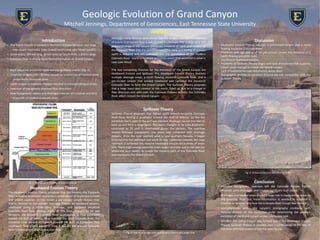
Poster Grand Canyon
- 1. Geologic Evolution of Grand Canyon Mitchell Jennings, Department of Geosciences, East Tennessee State University . Discussion • Headward Erosion Theory requires a pre-incised canyon and a north flowing Ancestral Colorado River. • Problems with age dating of the pre-incised canyon and evidence of a north flowing ancestral river. • Insufficient headward erosion. • Problems of Spillover Theory begin with lack of evidence that supports a basin large enough to create the Grand Canyon. • Lack of evidence for Lake Bidahochi’s water level. • Topographic profiles in northern Arizona are not compatible with the Spillover Theory. Conclusion • Miocene topographic inversion left the Colorado Plateau higher, reversed some drainages, and created significant fault scarps. • Drainages and faulted areas played a large role in transporting water to the Colorado River but more information is needed to establish a timeline as to when and how the Colorado River trough was formed. • Unconformities within the canyon’s stratigraphy combined with massive erosion of the landscape make determining the geologic evolution of the Grand Canyon a near impossible task. • Whether the Grand Canyon was formed due to the Headward Erosion Theory, Spillover Theory, or possibly even a combination of the two, at this time definitive evidence has not been found. Abstract Although many theories exist about how the canyon was cut, the timeline of events that explain how it was formed is unknown. The stratigraphy and geomorphology of the canyon preserves evidence of uplift and incision of the Colorado River into the Grand Canyon. The pace and timing of plateau uplift is debated and still unknown, but the occurrence of the modern Colorado River marks a localized extinction event that occurred in what is now Lake Mead. The two competing theories for the evolution of the Grand Canyon are Headward Erosion and Spillover. The Headward Erosion Theory involves multiple drainage areas, a north flowing ancestral Colorado River, and a pre-incised canyon that eroded headward and captured the Ancestral Colorado River to form the Grand Canyon. The Spillover Theory proposes that a large basin was created to the north, filled up due to a change in flow direction and spilt over the Colorado Plateau to form the Colorado River which incised the Grand Canyon. Spillover Theory Spillover Theory proposes that Kaibab uplift altered Ancestral Colorado River flow, forcing it southeast toward the Gulf of Mexico. 12 Ma the ancestral river’s path to the gulf was blocked. Blockage caused the river to back up and form a large basin. The basin, thought to be Lake Bidahochi, continued to fill until it overflowed across the plateau. The overflow stream followed topographic low areas and combined with drainage streams. Once the river reached what is now southern Nevada, it began to incise into the sediment and work its way upstream towards the large reservoir. It achieved this massive headward erosion via a series of water falls. These high-energy waterfall areas began to erode and incise into the landscape very rapidly to create the modern path of the Colorado River and eventually the Grand Canyon. Introduction • The Grand Canyon is located in Northern Arizona between two large man-made reservoirs: Lake Powell (north) and Lake Mead (south). • Dimensions; 360 km long, 30 km wide (at South Rim), 1,830 m deep. • Colorado River is driving force behind formation of Grand Canyon. • Rock sequence preserves eight sea transgression events (Fig. 1). • Laramide orogeny (70 – 80 Ma) caused by subduction of Farallon plate under North American plate. • Uplift unique to Colorado Plateau resulted in minimal tilting of strata. • Inversion of topography reversed flow directions. • New topographic valleys and drainage channels are created and form flow path of modern Colorado River. Headward Erosion Theory The Headward Erosion Theory proposes that the modern day Colorado River achieved its present course by a combination of headward erosion and stream capture. In this model a pre-incised canyon deeper than 600 m, formed on the western Hualapai Plateau by headward erosion, continued along a strike-valley drainage, and captured ancestral Colorado River flow. (Young, 2008) At this time, thought to be late Miocene, the ancestral Colorado River is projected to flow southeast toward the Gulf of Mexico. Near modern day Little Colorado River, the ancestral river turned northward toward the Gulf of California. This northward flow of the ancestral river is key for the present Colorado River’s interception of ancestral river flow. Fig. 1 Stratigraphic Column of Grand Canyon. Fig. 2 View of drainages and stratigraphy from Bright Angel Trail Fig. 3 Vishnu Schist and Zoroaster Granite